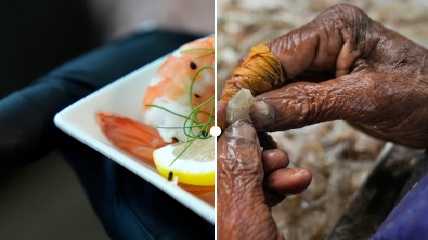
29 March 2024; AP: SAN FRANCISCO — Noriko Kuwabara was excited to try a new recipe she’d seen on social media for crispy shrimp spring rolls, so she and her husband headed to Costco’s frozen foods aisle. But when she grabbed a bag of farm-raised shrimp from the freezer and saw “Product of India,” she wrinkled her nose.
“I actually try to avoid shrimp from India,” said Kuwabara, an artist. “I hear some bad things about how it’s grown there.”
She sighed and tossed the bag in her cart anyway.
Kuwabara’s dilemma is one an increasing number of American consumers face: With shrimp the leading seafood eaten in the United States, the largest supplier in this country is India, where the industry struggles with labor and environmental problems.
The Associated Press traveled in February to the state of Andhra Pradesh in southeast India to document working conditions in the booming industry, after obtaining an advance copy of an investigation released Wednesday by the Chicago-based Corporate Accountability Lab, a human rights legal group, that found workers face “dangerous and abusive conditions.”
AP journalists obtained access to shrimp hatcheries, growing ponds, peeling sheds and warehouses, and interviewed workers, supervisors and union organizers.
India became America’s leading shrimp supplier, accounting for about 40% of the shrimp consumed in the U.S., in part because media reports including an AP investigation exposed modern day slavery in the Thai seafood industry. AP’s 2015 reporting led to the freedom of some 2,000 enslaved fishermen and prompted calls for bans of Thai shrimp, which had been dominating the market.
In India, residents told the AP newly dug hatcheries and ponds had contaminated neighboring communities’ water and soil, making it nearly impossible to grow crops, especially rice they depend on for food.
From the ponds, trucks hauled the shrimp to peeling sheds. In one shed, dozens of women, some barefoot, stood on narrow wooden benches enduring 10-hour shifts peeling shrimp covered in crushed ice. Barehanded or wearing filthy, torn gloves, the women twisted off the heads, pulled off the legs and pried off the shells, making it possible for American cooks to simply tear open a bag and toss the shrimp in a skillet...
Another peeler, Penupothula Ratnam, said she suffers back pain all the time from the arduous work, for which she’s paid about $3 a day.
“It’s not enough for our living,” she said, breaking into tears. Rarely does she get a day off, she said.
Many people in India struggle to survive amid endemic poverty, debt and unemployment. The women AP spoke with said this work, despite the oppressive conditions, is their only chance to avoid starvation. The economic drivers go beyond shrimp, and beyond India, to issues of globalization and Western power.
Desperately poor women told AP they weren’t paid overtime as mandated by law, in addition to not being paid India’s minimum wage. Some said they were locked inside guarded hostels when they weren’t peeling shrimp. The work was unsanitary to the point that workers’ hands were infected, and they lacked safety and hygiene protection required under Indian law. And it doesn’t meet U.S. legal food safety standards required for all seafood imports.
Dr. Sushmitha Meda, a dermatologist at a nearby government hospital in the city of Kakinada, said she treats four to five shrimp peelers every day. Some have nail fungus, caused by small cracks that allow germs to cause infections. Other women have fingers or even their entire hands darkening with frostbite. Meda said that sometimes she has to amputate.




